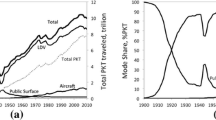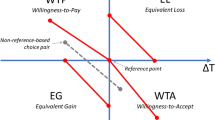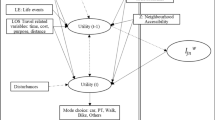Abstract
The parameters for travel time and travel cost are central in travel demand forecasting models. Since valuation of infrastructure investments requires prediction of travel demand for future evaluation years, inter-temporal variation of the travel time and travel cost parameters is a key issue in forecasting. Using two identical stated choice experiments conducted among Swedish drivers with an interval of 13 years, 1994 and 2007, this paper estimates the inter-temporal variation in travel time and cost parameters (under the assumption that the variance of the error components of the indirect utility function is equal across the two datasets). It is found that the travel time parameter has remained constant over time but that the travel cost parameter has declined in real terms. The trend decline in the cost parameter can be entirely explained by higher average income level in the 2007 sample compared to the 1994 sample. The results support the recommendation to keep the travel time parameter constant over time in forecast models, but to deflate the travel cost parameter with the forecasted income increase among travellers and the relevant income elasticity of the cost parameter. Evidence from this study further suggests that the inter-temporal and the cross-sectional income elasticities of the cost parameter are equal. The average elasticity is found to be −0.8 to −0.9 in the present sample of drivers, and the elasticity is found to increase with the real income level, both in the cross-section and over time.


Similar content being viewed by others
Notes
Variations in marginal utility of money and time in the population may be relevant in appraisal in the specific decision context of prioritizing infrastructure investment projects financed with tax money, see Mackie et al. (2001).
1{x > y} is defined to take the value 1 if x > y and 0 otherwise.
In both survey waves a predetermined share of company owned cars were recruited. In 1994, 20 % (more than the actual share on the road) of the recruited cars was owned by companies and 90 % of these was business trips and is thus not included in the analysis in this paper. In 2007, 17 % of the recruited cars were company-owned cars; this share was taken from the national travel survey and reflects the accrual share on the road.
This is partly because the numbers to mobile phones are not available to the same extent as the numbers for fixed telephones in Sweden. The use mobile phones have increased and while fixed telephone subscriptions have decreased substantially between the survey years. Other surveys, for instance the national travel survey experience the same problem.
These observations would not have had to be discarded if applying an ordered logit model in the estimation. However, it is not possible to have panel effects in an ordered logit model in Biogeme (Bierlaire 2003), and for this reason the observations are removed.
The maximum of the log-likelihood function is not affected whether the serial correlation between observations from the same individuals is taken into account or not. However, when the serial correlation is not taken into account, the efficiency of the estimation will decrease. This means essentially, that the estimates get more imprecise when not taking account of the serial correlation, given the number of observations. Hence, for small sample sizes, this may give rise to errors, because the accuracy declines as the estimation become less efficient.
References
Abrantes, P.A.L., Wardman, M.R.: Meta-analysis of UK values of travel time: an update. Transp. Res. Part A 45(1), 1–17 (2011)
Algers, S., Lindqvist-Dillén, J., Widlert, S.: The national swedish value of time study. Paper presented at the PTRC European Transportation Forum in Warwick 1995. Proceedings of seminar F, P393 ISBN 0-86050-283-X (1995)
Amador, F.J., González, R.M., Ortúzar, J.D.: Preference heterogeneity and willingness to pay for travel time savings. Transportation 32(6), 627–647 (2005)
Axhausen, K.W., Hess, S., Konigb, A., Abayc, G., Bates, J.J., Bierlaire, M.: Income and distance elasticities of values of travel time savings: new Swiss results. Transp. Policy 15, 173–185 (2008)
Badoe, D., Miller, E.: Analysis of the temporal transferability of disaggregate work trip mode choice models. Transp. Res. Rec. 1493, 1–11 (1995)
Bateman, I., Munro, A., Rhodes, B., Starmer, C., Sugden, R.: A test of the theory of reference-dependent preferences. Q. J. Econ. 112(2), 479–505 (1997)
Bates, J., Whelan, G.: Size and sign of time savings. ITS Working Paper no. 561 (2001)
Becker, G.S.: A Theory of the allocation of time. Econ. J. 75(299), 493–517 (1965)
Beesley, M.E.: The value of time spent in travelling: some new evidence. Economica 32(126), 174–185 (1965)
Beser, M., Algers, S.: SAMPERS—The new Swedish national travel demand forecasting tool. In: Lundqvist, L., Mattsson, L.-G. (eds.) National transport models: Recent developments and prospects. Springer, Heidelberg (2002)
Bierlaire, M.: BIOGEME: A free package for the estimation of discrete choice models. Proceedings of the 3rd Swiss Transportation Research Conference, Ascona, Switzerland (2003)
Börjesson, M.: Valuating perceived insecurity associated with use of and access to public transport. Transp. policy 22, 1–10 (2012)
Börjesson, M., Eliasson, J.: Experiences from the Swedish value of time study. CTS Working paper, 8 (2012)
Börjesson, M., Fosgerau, M., Algers, S.: On the income elasticity of the value of travel time. Transp. Res. A. 46(2), 368–377 (2012a)
Börjesson, M., Fosgerau, M., Algers, S.: Catching the tail: empirical identification of value of time distribution. Transp. Res. A. 46(2), 378–391 (2012b)
Cameron, T.A., James, M.D.: Efficient estimation methods for “Closed-ended” contingent valuation surveys. Rev. Econ. Stat. 69(2), 269–276 (1987)
Cherchi, E., Ortúzar, J.de D.: Can mixed logit infer the actual data generating process? Some implications for environmental assessment. Transp. Res. D 15(7), 428–442 (2010)
Cirillo, C., Axhausen, K.W.: Evidence on the distribution of values of travel time savings from a six-week diary. Transp. Res. Part A 40(5), 444–457 (2006)
Cirillo, C., Daly, A.J., Lindveld, K.: Eliminating bias due to the repeated measurements problem. In: de Ortúzar, J.D. (ed.) Stated preference modelling techniques, pp. 137–154. PTRC, London (2000)
Daly, A., Tsang, F., Rohr, C. (2011): The value of small time savings for non-business travel. Paper presented at the European Transport Conference, Glasgow (2011)
De Borger, B., Fosgerau, M.: A test of the theory of reference-dependent preferences: the trade-off between money and time. J. Urb. Econ. 64(1), 101–115 (2008)
De Serpa, A.C.: A theory of the economics of time. Econ. J. 81, 828–846 (1971)
Engelson, L., Svalgård, S.: SYNERGETIC—The travel demand and landuse model for the Stockholm region EMME/2 implementation and calibration technique, presented at 4th European EMME/2 Users’ Conference. http://www.inro.ca/en/pres_pap/european/eeug95/Europe01_1995.pdf (1995). Accessed 26 July 2013
Evans, A.W.: On the theory of the valuation and allocation and time. Scott. J. Political Econ. 19(1), 1–17 (1972)
Fosgerau, M.: Investigating the distribution of the value of travel time savings. Transp. Res. Part B 40(8), 688–707 (2006)
Fowkes, A.S.: Issues in evaluation. A Justification for awarding all time savings and losses, both small and large, equal unit value in scheme evaluation, in Accent/Hague op. cit., pp. 341–359. (1999)
Fox, J.: Temporal transferability of mode-destination models: summary of literature, initial findings. Proceedings from the European Transport Conference, 2011
Fox, J., Hess, S.: Review of evidence for temporal transferability of mode-destination models. Transp. Res. Rec. 2175, 74–83 (2010)
Gunn, H.: Spatial and temporal transferability of relationships between travel demand, trip cost and travel time. Transp. Res. E 37, 163–189.20 (2001)
Gunn, H.F., Tuinenga, J.G., Cheung, Y.H.F., Kleijn, H.J.: Value of Dutch travel time savings in 1997.In: Proceedings of the 8th World Conference on Transport Research, vol. 3, pp. 513–526. (1999)
Hess, S., Bierlaire, M., Polak, J.W.: Estimation of value of travel-time savings using mixed logit models. Transp. Res. Part A 39(2–3), 221–236 (2005)
Hjorth, K., Fosgerau, M.: Using prospect theory to investigate the low marginal value of travel time for small time changes. Transp. Res. Part B: Methodol 46(8), 917–932 (2012). doi:10.1016/j.trb.2012.04.001
Hultkrantz, L., Mortazavi, R.: Anomalies in the value of travel-time changes. J. Transp. Econ. Policy 35(2), 285–300 (2001)
Jara-Díaz, S.R.: On the goods-activities technical relations in the time allocation theory. Transportation 30(3), 245–260 (2003)
Jara-Diaz, S.R., Guevara, S.R.: Behind the subjective value of travel time savings. J. Transp. Econ. Policy 37, 29–46 (2003)
Karasmaa, N., Pursula, M.: Transferability analysis of disaggregate choice models. Transp. Res. Rec. 1607, 38–44 (1997)
Mackie, P.J., Jara-Diaz, S.R., Fowkes, A.S.: The value of travel time savings in evaluation. Transp. Res. E 37, 91–106 (2001)
McCarthy, P.: Further evidence on the temporal stability of disaggregate travel demand models. Transp. Res. B 16(4), 263–278 (1982)
Ramjerdi, F., Flügel, S., Samstad, H., Killi, M.: Value of Time, Safety and Environment in Passenger Transport. Transportøkonomisk institutt,Oslo http://www.toi.no/article29726-29.html (2010). Accessed 26 July 2013
Román, C., Martín, J.C., Espino, R., Cherchi, E. Ortúzar, J. de D., Gonzales, R.M., Amador, F.J., Rizzi, L.I.: Valuation of travel time savings for intercity travel: the Madrid–Barcelona corridor. XVII Panamerican Conference. Santiago, Chile, 2012
Silman, L.: The time stability of a modal-split model for Tel-Aviv. Environ. Plan. A 13, 751–762 (1981)
Tapley, N., Wardman, M., Gunn, H., Hyman, G. (2007): Inter-temporal variations in values of time in Great Britain. Paper presented at the European Transport Conference (2007)
Train, K.: A validation test of a disaggregate mode choice model. Transp. Res. 12, 167–174 (1978)
Train, K., McFadden, D.: The goods/leisure tradeoff and disaggregate work trip mode choice models. Transp. Res. 12, 349–353 (1978)
Wardman, M.: A review of British evidence on time and service quality valuations. Transp. Res. Part E 37(1–2), 107–128 (2001a)
Wardman, M.: Inter-temporal variations in the value of time, ITS Working Paper 566 (2001b)
Acknowledgments
I am indebted to Staffan Algers for help with data and to Jonas Eliasson and Staffan Algers for fruitful discussions. Financial support from the Swedish Road and Rail Administrations and VINNOVA and Centre for Transport studies, KTH, is also gratefully acknowledged.
Author information
Authors and Affiliations
Corresponding author
Rights and permissions
About this article
Cite this article
Börjesson, M. Inter-temporal variation in the travel time and travel cost parameters of transport models. Transportation 41, 377–396 (2014). https://doi.org/10.1007/s11116-013-9493-2
Published:
Issue Date:
DOI: https://doi.org/10.1007/s11116-013-9493-2




